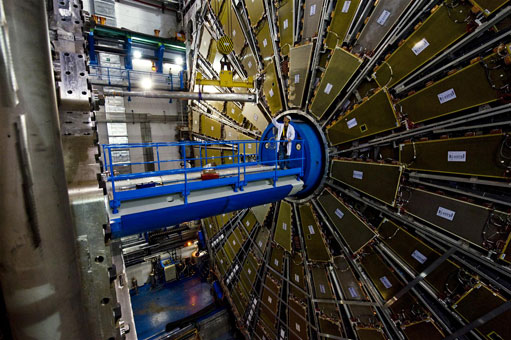
ATLAS e-News
23 February 2011
Pipe down!
23 June 2008

The beampipe mid-lowering, last Monday
On Monday, two of the very last pieces of ATLAS entered the cavern: the beampipes that connect the detector to the rest of the LHC. The importance of this milestone extends beyond our own collaboration as these pieces are the last parts of the LHC vacuum system.
“It means we’re very very close now to circulating the beam,” says Ray Veness, section leader in charge of vacuum engineering at CERN.
The first parts of the beampipe entered the cavern in June of last year. Installation activity continued until August when other parts of ATLAS took precedence.
When the detector started to close in March, beampipe activity picked up again. “It’s been very very hectic since then, really,” Ray describes. “We’ve had teams down in the cavern most days.”
They aren’t just running tests either. The beampipe must be as thin as possible so that it is unlikely to disturb the particles flying through it into the detectors, and thus it is extremely fragile.
“We’ve also been trying to protect it from damage from other things that are going on,” Ray explains, “because, of course, it goes right through the middle of the experiment, so everyone wants to be there.” Other groups build and remove levels of scaffolding, work from ladders, and install subdetector parts.
Coordination poses another challenge for working in dense detector spaces. They need to respect the tight schedule, make sure that everyone involved has cavern access, and avoid disturbing other work. “There’s a huge amount of coordination, more than there is in the machine in some ways,” says Ray.
On Tuesday, the vacuum group tested the pipes for leaks and found none. Leak-free beampipes are critical to the LHC because the protons are liable to hit any stray gas particles floating around. The vacuum must be as perfect as possible since extra radiation occurring in areas other than the collision points risks damaging the detectors or LHC magnets.
Wednesday, a team of surveyors aligned the beampipe through the cavern. Ray notes the difficulty of their task, as “the beampipe is sitting in the huge volume of the cavern, and you want it to be positioned to a few tenths of a millimeter on a line that is, for the moment, just completely virtual.”
The accuracy of its alignment is essential to ATLAS because the collisions should happen in the center of the beampipe. If they are occurring elsewhere in the cylinder, we’ll see asymmetrical signals in the detectors.
Should the proton bunches be as far off as 2.7 centimeters, they could hit the side of the beampipe, burning a hole in it and forcing the entire accelerator to stop. Ray, however, is confident that we’ll never see this disaster scenario.
This week, the team must check the cables, heaters, pumps and gauges to make sure that everything is in working order before pumping the air out of the tube, hopefully for the last time before the protons arrive.
“Bake-out,” the process of heating the beampipe to get rid of all the water and other stray particles on the chamber walls, and activation of the absorbent ‘sticky’ pump are the last steps before the pipe is ready to house a beam. The cooling systems must be prepared for this process or else the heat risks damaging the nearby pixel.
“If the pixel cooling is ready as planned, we should have the chamber baked-out and ready for beam by the end of July,” says Ray.

Katie McAlpineATLAS e-News
|